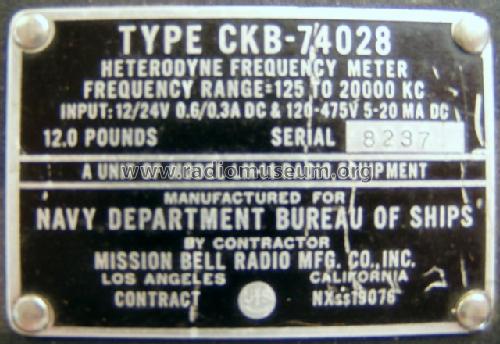Heterodyne Frequency Meter CKB-74028
MILITARY U.S. (different makers for same model)
- Country
- United States of America (USA)
- Manufacturer / Brand
- MILITARY U.S. (different makers for same model)
- Year
- 1943
- Category
- Service- or Lab Equipment
- Radiomuseum.org ID
- 83999
Click on the schematic thumbnail to request the schematic as a free document.
- Number of Tubes
- 3
- Wave bands
- Wave Bands given in the notes.
- Power type and voltage
- Other, details in remarks or not known. / 12/24; 200-475 Volt
- Loudspeaker
- - only for Earphone!
- Material
- Metal case
- from Radiomuseum.org
- Model: Heterodyne Frequency Meter CKB-74028 - MILITARY U.S. different makers
- Shape
- Tablemodel, with any shape - general.
- Dimensions (WHD)
- 8.5 x 8.5 x 8.44 inch / 216 x 216 x 214 mm
- Notes
- Unit of LM-14 radio equipment. Frequency range 125 - 250 kHz and 2 - 4 MHz, as well as it's harmonics up to 20 MHz. Different variants from numerous manufacturers.
- Net weight (2.2 lb = 1 kg)
- 5.2 kg / 11 lb 7.3 oz (11.454 lb)
- Source of data
- -- Collector info (Sammler)
- Author
- Model page created by Felix Schaffhauser. See "Data change" for further contributors.
- Other Models
-
Here you find 408 models, 360 with images and 215 with schematics for wireless sets etc. In French: TSF for Télégraphie sans fil.
All listed radios etc. from MILITARY U.S. (different makers for same model)
Collections
The model Heterodyne Frequency Meter is part of the collections of the following members.
Forum contributions about this model: MILITARY U.S.: Heterodyne Frequency Meter CKB-74028
Threads: 1 | Posts: 1
The 74028 heterodyne frequency meter is the main part of the model LM-(*) crystal calibrated frequency indicating equipment, in the models LM-10 and higher, for use in the Naval radio service.
The 3 letter code is a manufacturer identification: CRR=Bendix Radio, CKB= Mission Bell Radio, and CBLC=Loral Electronics. There might be more manufacturers.
The LM-1 to LM-9 equipment used a similair frequency meter with a low range oscillator from 195-400 Khz.
Jan Terranea.
Jan Terranea, 26.Apr.10














